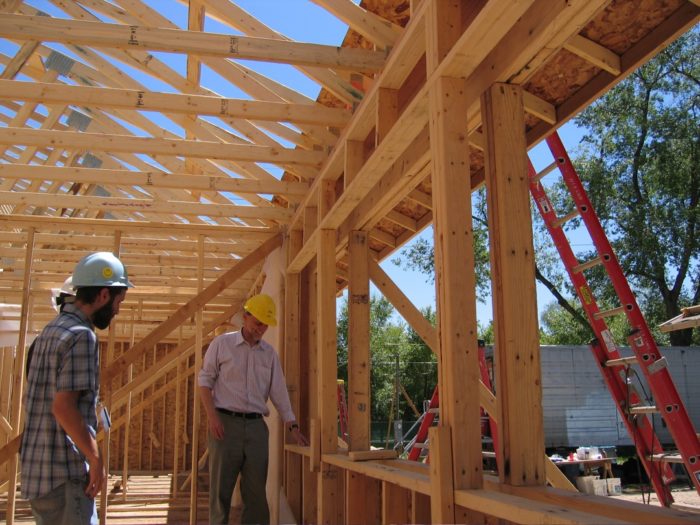
Image Credit: NREL
John Holscher has done enough research to know there are many ways of building and insulating an energy-efficient home. Options include double-stud walls, 2×6 walls with rigid foam on the exterior, and structural insulated panels.
Now he has to figure out which one makes the most sense for his Cape-style home in New England.
“So many options, so little time,” he writes in his Q&A post.
“I’d also like to avoid (as much as I can) petrochemical-based products and use as many natural and/or recycled products as possible,” Holscher adds. “I understand the argument that using foam insulation in the end saves more oil than is used to produce it, but if I can get equal or better results using natural/recycled, all the better.”
First, start with a smaller, simpler house
“The most cost-effective approach to an efficient home is to build only the space actually required for basic shelter, which is generally no more than half of what the typical American believes they need,” writes Robert Riversong.
No matter what materials you use, or how the house is built, using fewer resources by building smaller lowers both operating and maintenance costs, Riversong says. “A half-sized house can have half the R-value and still be energy efficient.”
Riversong’s recommendations for the most cost-effective approach are simplicity over complexity. “The most cost-effective building system for a temperate climate?” he asks rhetorically. “Structural straw bale with earthen plaster, cordwood masonry with earthen floor, or scribed log construction, with no interior plumbing or wiring, a simple woodstove or Rumford fireplace, a shallow well with windlass bucket or gravity-fed spring and a rain barrel, and a pleasant composting outhouse.”
James Morgan likes the “small” part, but not all of Riversong’s details. “The very first concern for an aspiring green…
Weekly Newsletter
Get building science and energy efficiency advice, plus special offers, in your inbox.

This article is only available to GBA Prime Members
Sign up for a free trial and get instant access to this article as well as GBA’s complete library of premium articles and construction details.
Start Free TrialAlready a member? Log in





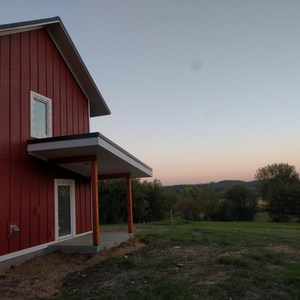
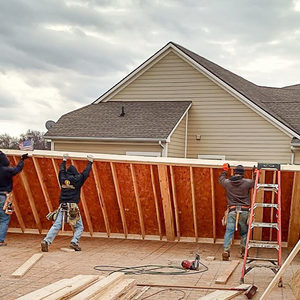
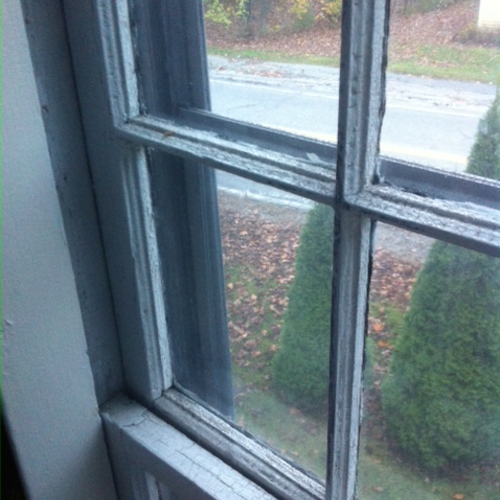
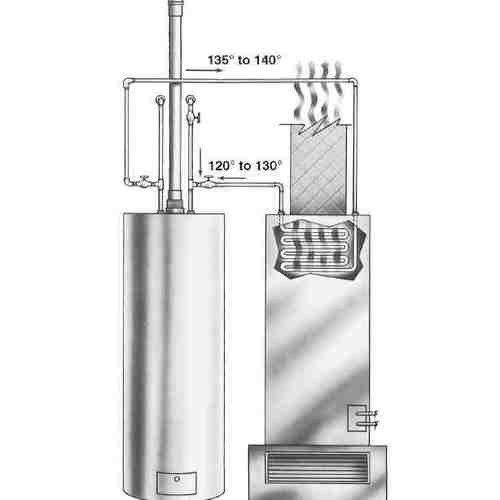






19 Comments
Best wall system
What a great article! I build with straw bales and have custom SIP columns manufactured which I use as insulated stud. They are 4 1/2" x 14", wide enough for a bale. We build a balloon frame and run the bales right up, between the studs. we end up with consistent insulation and plenty of frame for windows, siding, ledgers etc... The frame goes up real fast and is stronger than He**. I have been using SIP roofs but have the same concern over those rotting seams. I'm ready to try a cellulose system.
More on David Lanfear's homes
If GBA readers are interested in reading more on David Lanfear's building system -- using custom-made "insulated studs" with straw-bale infill -- we did a short news story on one of his houses way back on January 7, 2009. Here's the link:
A Near-Zero-Energy House In Upstate New York
Interesting...
David,
Is it possible to get more information on building details? Specifically:
How are the top plates made?
Is the floor framed as a standard platform?
Have you ever used trusses over this wall?
How does the cost of materials compare to other systems?
Non-vented roof
Cellulose on a hot (nonvented) roof is illegal. The international building code (& IRC) reads that some requirements must be met with a non-vented roof application, those being:
1. No interior vapor barriers are installed on the ceiling side (attic floor)
2. An air-impermeable insulation is applied in direct contact to the underside/interior of the structural roof deck. "Air-impermeable" shall be defined by ASTM E 283.
3. In zones 2B & 3B air-impermeable insulation not reqd.
4. In zones 3-8 sufficient insulation is installed to maintain the average monthly temperature of the condensing surface above 45F. The condensing surface is either the structural roof deck or the interior surface of the air-impermeable insulation.
The scientific test mentioned, ASTM E283, is very strenuous and there is no way any loose fill material like cellulose will pass even if it is dense packed. Icynene brand foam passes this criteria as well as most if not all closed cell foams.
This dense pack on the roof is a too common practice. Reading it here is the third time I've heard about it this week! Two other places were actually in use (or planned to be used) on the job site! Like I tell everyone, that is illegal for reasons stated above and I make it a point to educate all building officials I talk to. Eventually you will get failed and have to remove all the cellulose & correct the situation.
I own a spray foam insulation company so you know what side I'm on. I only give the facts, please verify with science & facts if you'd like to add to the conversation. I'm always looking to learn.
unvented, non-breathing roof
There is no problem with using an unvented, non-breathing roof with Cellulose. The denseness of tight pack cellulose prevents air movement inside or though the insulation, and a vapor retarding primer virtually eliminates migration of water vapor through the drywall into the insulation. My architect gave me an article (which I can not put my hands on) explaining the concept so my inspector would approve the application. My first application of this type is 11 years old with no problems.
There is a good discussion on the subject by Applegate Insulation ( a manufacturer of cellulose insulation) at this link; http://www.applegateinsulation.com/Product-Info/Technical-Pages/249234.aspx
Response to Stuart Fearn
Stuart Fearn,
The suggestion to install dense-packed cellulose in an unvented cathedral ceiling came from Graham Mink, a GBA reader who posted the suggestion on our Q&A page. (This report is a summary of postings by GBA readers.) We reported that Robert Riversong replied that the suggestion of using cellulose in an unvented cavity wasn't a great idea; Riversong suggested that the cavities should be vented.
My own suggestion for building an insulated roof did not include any mention of dense-packed cellulose without ventilation.
In the GBA Encyclopedia, this is what we have to say on the topic: "Installing insulation in rafter bays is risky, as interior moisture can migrate through the insulation (either by diffusion or by piggybacking with exfiltrating air) and contact the cold roof sheathing, leading to condensation. This problem can be prevented by using closed-cell spray polyurethane foam, with or without a ventilation channel under the roof sheathing."
One final point: there is a safe way to install cellulose between rafters without any venting. The method requires installing a thick layer of rigid foam insulation on top of the roof sheathing (followed by strapping or a second layer of roof sheathing). The rigid foam above the sheathing keeps the sheathing warm enough to avoid problems of condensation or moisture accumulation. If the sheathing is kept warm, the installation of cellulose between the rafters is safe.
no-vent cellulose roof
I just built a cathedral roof assembly with an 8" EPS SIP panel on top of 2x12 rafters with dense pack cellulose in teh rafter cavities and drywall on interior. R-value of the SIP is about R-30 which protects the condesning surface, R-value of the cavity is about R-40 ... total R-value of assembly about R-70. The main improvement I think should be made to this is approach is less wood than the 2x12 with the use of open web truss, TJI or some other technique than big boards like I did.
A comment about the legality of unvented roof by the spray foam contractor ... are you sure those IRC rules you quoted are not related particulary to unvented attics ... not enclosed cathedral ceiling cavities?
Insulating in the South
Hi, we just moved from Colorado to Aberdeen, Mississippi - and all of our home building knowledge is turned upside down! What would be the best insulation to use down here? We have a totally gutted brick house which we intend on spraying the interior with closed cell foam. We then need to insulate but it's high humidity here in the summer and we dont want anything that will "hold" the moisture. Your thoughts would be appreciated. Thanks!
Response to Kirky
Kirky,
I'm confused. You wrote that you "intend on spraying the interior with closed cell foam. We then need to insulate." But closed-cell foam is a type of insulation.
Are you saying that the spray foam will be installed in a very thin layer, and you want to use a different product in addition to the spray foam?
Or are you asking about insulating your attic, basement, or crawl space walls?
Re: Alternative to Larsen Truss
On March 10, 2010 Harold Orr, developer of many of the energy efficient building techniques still used today, made a presentation to the Solar Energy Society in Edmonton, AB on an energy efficient retrofit of a 4 plex in Regina, SK which he had done. On slide no. 17 he shows a support for an non-structural exterior wall that he had found at building supply store (can't remember which one). It looked to me like a short hockey stick made of stainless steel with a flat support instead of a blade. He first installed a 6 mil poly vapor barrier on the outside of the existing plywood and then he bolted or screwed them to the existing outside wall at 4 foot on center and constructed a non structural exterior wall from 2x4s 4 foot on center, hung from eaves and covered them with plywood. As I recall it provided a 12" space (?) which he filled with cellulose. I was amazed at how much easier and faster it looked to be rather than using Larsen trusses which I had first seen when John Larsen made a presentation in the late 1970s.
Easier or better?
Frank Hanlan,
The Orr technique you describe puts a lot of highly conductive steel thermal bridges and condensation points within a cellulose-filled cavity. Easier? Perhaps, but hardly better than Larsen Trusses which use non-conductive materials to create the cavity.
I've built or designed nearly every permutation of double-wall house and none is as quick, easy, effective or resource-efficient as the modified Larsen Truss.
In fact, I'm consulting with John Holscher (the subject of the above blog) on how to convert his current plans to a Riversong Truss system.
Where's the Feature?
Scott,
Thanks for highlighting some of my comments and approaches to ecological and responsible building. It's a shame, though, that the Green Homes feature I submitted in December of last year has yet to be published on this website, as that would offer a much more complete perspective on the building approach I've developed over 30 years in the field.
Though he denies it, I can't help but wonder whether my regular challenging of Martin's posts and blogs has put my fully-formatted submission on the backburner while he continues to feature homes that are more in sync with his own "green" building bias.
SIPS Roof
Martin,
You should take a look at Eco-Panels, http://www.eco-panels.com . An 8-1/2" thick panel will give you R60 and a double tongue and grove joint with a foam sealer should take care of your leaks.
Re: Alternative to Larsen Truss by Frank Hanlan
The stainless steel hockey stick, is in fact a strip of galvanized perforated "plumbers strap" at 4 ft OC. The lower end is nailed to the bottom plate, carried diagonally through the insulation space and the top hole is nailed to a stud on the old wall, additional nails are added to tighten the strap The straps at 4' oc allow insulation batts to fit between the straps.
building eco-friendly homes/Cathedral ceilings & insulation
I'm designing and building passive solar slab homes (6-8" concrete floors) which range from 1000-1700 s.f. in Jaffrey New Hampshire area. The framing will be Advanced Framing 2x6 24 oc exterior walls, 2x4 interior walls and 2x10 rafters. Most of the houses will only be 20' (true south-North) deep due to sun penetration. My roof pitches will be 8, 10 & 12 depending on the design. There will be no attic space only insulated cathedral ceilings with lofts. There will be also be ridge and soffit vents.
I am leaning towards the National Fiber Cell-Pak Cellulose for insulation. I like the fact that it is made from recycled newspapers and borates. I would like to use the ZIP system sheathing with Metal roofing & gutters for rainwater harvesting and also the Zip system for the walls. The siding will be fiber cement. Your input on the following questions would be helpful:
Have you used the Zip Roof and Wall sheathing and how do they hold up with metal roofing?
Regarding energy savings is there a real difference using 2x12 rafters rather than 2x10 rafters?
What is the best non toxic insulation for cathedral ceilings?
Is National fiber cell-pak cellulose a good fit? From the above sound board it's a little bit confusing.
Thanks,
Response to Maria Hars
Maria,
Q. "Have you used the Zip Roof and Wall sheathing and how do they hold up with metal roofing?"
A. I have never used the Zip System sheathing, but I have spoken to many builders who have used it. All reports so far are very positive. It seems to hold up well. There is no reason you can't use it under metal roofing.
Q. "Regarding energy savings is there a real difference using 2x12 rafters rather than 2x10 rafters?"
A. Any difference in energy performance is due to the insulation R-value and air-barrier details, not the size of the rafters. One house with 2x10 rafters can be much better insulated than a neighboring house with 2x12 rafters.
If you are building an insulated sloped roof, you need to have a plan to address thermal bridging through the rafters. Methods include the use of rigid foam below the rafters, rigid foam above the roof sheathing, or cross-hatching with 2x4s below the rafters to increase insulation depth.
Q. "What is the best non toxic insulation for cathedral ceilings?"
A. Properly installed, all legal insulation types are non-toxic and will not poison your family. (That said, some homeowners have complained that improperly installed spray foam insulation can leave a lingering odor and in some cases may contribute to respiratory symptoms.)
Q. "Is National fiber cell-pak cellulose a good fit?"
A. Yes.
Well done!
Awesome article. Practical, useful and exactly the kind of thing people ask me for. Planning to rip this off...err. share with folks left and right.
Thank you!
Rural builders
Can't help but think there are no solutions here for what has to be the greenest way to live: IN A CITY!
Rain barrel? Outhouse? Straw bales 20stories high?
City infill, Eco-Panels
Steven, living in a city doesnt mean youre restricted to commercial construction. All city infill residential construction can use the efficient methods above.
On Eco-Panels, we have done two homes using them. They offer two methods of panel connections for roof panels and we have done both. We do not recommend the OSB spline method, it was very crude. The tongue and groove that you mention was much better. While we feel pretty good about the elimination of thermal bridging with this product and connection you still have to be very meticulous when it comes to the air sealing. The joints do not match up perfectly and canned foam, caulk and tape should all be used to ensure an air seal. We feel good about the level of airtightness achieved and would have a hard time justifying additional insulative sheathing just to stop air movement. The SIP failure case mentioned seemed to be from NO attempt of air sealing the joints.
Log in or become a member to post a comment.
Sign up Log in